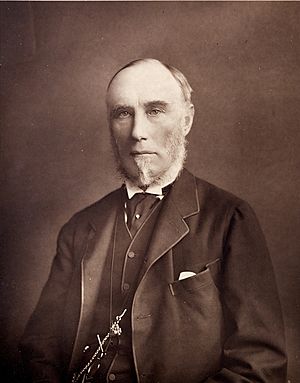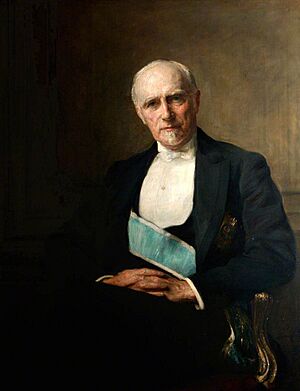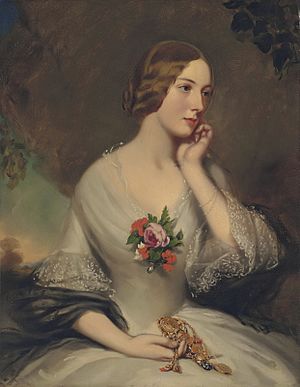Thomas Baring, 1st Earl of Northbrook facts for kids
Quick facts for kids
The Earl of Northbrook
|
|
|---|---|

The 1st Earl of Northbrook, c. 1889
|
|
| Lord Lieutenant of Hampshire | |
| In office 7 November 1890 – 15 November 1904 |
|
| Monarch | Victoria |
| Preceded by | The Lord Carnarvon |
| Succeeded by | The Lord Winchester |
| Governor-General of India | |
| In office 3 May 1872 – 12 April 1876 |
|
| Monarch | Victoria |
| Preceded by | The Lord Napier |
| Succeeded by | The Lord Lytton |
| Member of Parliament for Penryn and Falmouth |
|
| In office 24 April 1857 – 15 October 1866 |
|
| Preceded by | Howel Gwyn |
| Succeeded by | Jervoise Smith |
| Personal details | |
| Born |
Thomas George Baring
22 January 1826 |
| Died | 15 November 1904 (aged 78) Stratton Park, Hampshire |
| Nationality | British |
| Political party | Liberal |
| Spouse |
Elizabeth Sturt
(m. 1848; died 1867) |
| Alma mater | Christ Church, Oxford |
Thomas George Baring, 1st Earl of Northbrook (born 22 January 1826, died 15 November 1904) was an important British politician from the Liberal Party. He was known for his work as Governor-General of India from 1872 to 1876. During this time, he worked hard to improve the way India was governed under British rule. He helped reduce taxes and solve problems to prevent hunger and social unrest. Later, he also served as the head of the Royal Navy as First Lord of the Admiralty from 1880 to 1885.
Contents
Early Life and Learning
Thomas George Baring was the oldest son of Francis Baring, 1st Baron Northbrook. His mother, Jane, passed away when he was almost thirteen. Thomas was taught at home by a tutor, Mr. Bird. He was very interested in nature, even writing to his father about catching a rare butterfly!
He also went to France for a short time to learn French from another tutor. Thomas enjoyed sketching and learned from artists like S. Palmer and his friend Edward Lear. In 1843, he went to Christ Church, Oxford university and finished his studies with high honors in 1846. After university, he traveled around Europe and enjoyed mountain climbing with his friend Alfred Seymour.
Starting a Political Career
Thomas Baring began his career in politics. He worked as a private secretary for several important government officials. These roles helped him learn a lot about how the government worked.
In 1857, he became a Member of Parliament for Penryn and Falmouth. He held this position until 1866 when his father passed away, and he became a peer (a member of the House of Lords). During these years, he held various government roles, including:
- Working for the Royal Navy (Civil Lord of the Admiralty).
- Helping with war matters (Under-Secretary of State for War).
- Assisting with Indian affairs (Under-Secretary of State for India).
- Working for the Home Department (Under-Secretary of State for the Home Department).
Becoming Viceroy of India
When William Ewart Gladstone became Prime Minister in 1868, Thomas Baring was again appointed Under-Secretary of State for War. In February 1872, he was given a very important job: Viceroy of India. This meant he was the highest British official in India. On May 3, he was also made a Knight Grand Commander of the Order of the Star of India.
As Viceroy, he worked to improve life in India. He tried to make agreements that could have prevented the Second Anglo-Afghan War. However, his ideas were not always supported by others in the government. He resigned from his role in India in January 1876.
Later Political Roles
In 1876, Thomas Baring was given the titles Viscount Baring and Earl of Northbrook.
From 1880 to 1885, he served as First Lord of the Admiralty in Gladstone's government. This role put him in charge of the Royal Navy. During this time, there was public concern about the navy's strength, leading to calls for more shipbuilding.
In 1884, Northbrook was sent to Egypt to look into its financial situation. His mission was to help solve complex financial problems. He suggested that Britain should have more control over Egypt's finances. When Gladstone formed his next government in 1886, Northbrook did not join because he disagreed with the Prime Minister's policy on Home Rule for Ireland. After this, he took a less active role in politics.
Other Contributions
Beyond politics, Lord Northbrook was involved in several other areas:
- He served in the Hampshire Yeomanry, a military unit, and became its Honorary Colonel in 1889.
- In 1890, he was appointed Lord Lieutenant of Hampshire, a representative of the monarch in the county.
- He was president of the Northbrook Indian Society, which focused on Indian affairs.
- From 1890 to 1893, he was president of the Royal Asiatic Society, an organization dedicated to Asian studies.
- In 1898, he sold land for Manor House Gardens to the London County Council. He also gave land in Lee for public use, which became Northbrook Park in 1903.
- In 1902, he was elected a Fellow of the Royal Botanic Society.
Family Life
Lord Northbrook married Elizabeth Sturt in 1848. They had two sons and one daughter. Sadly, Elizabeth passed away in June 1867 at the age of 40. Lord Northbrook never remarried. He died at Stratton Park, Hampshire, in November 1904, at 78 years old. His eldest son, Francis, took over his title. There is a memorial for him at All Saints Church in East Stratton.
Legacy in India
Lord Northbrook's time as Viceroy left a lasting mark in India.
- The Ghanta Ghar Multan, or Clock Tower of Multan in Pakistan, was named 'Northbrook Tower' in his honor.
- A library called 'Northbrook Hall' is located in Dhaka, the capital of Bangladesh.
See also
- Northbrook Hall
- Manor House Gardens



